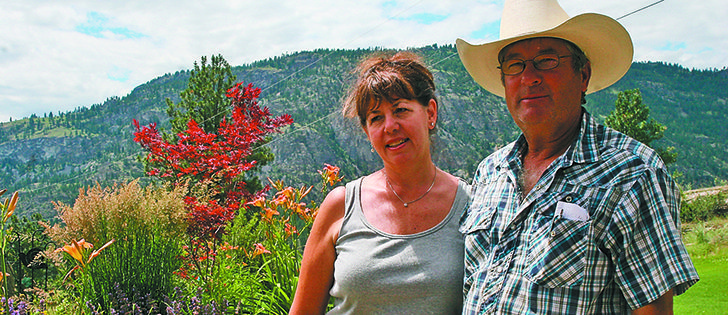Water management | Creeks feed gravity irrigation system and water is collected in reservoir
OKANAGAN FALLS, B.C. — Casorso Ranch is well hidden at the end of a winding gravel road in the hills towering over the southern end of British Columbia’s Okanagan Valley.
Located between Okanagan Falls and Oliver, the ranch is a desert beauty with steep terraces of rock that jut out over fragile grasslands and irrigated forage crops.
The care that Dave and Wanda Casorso have given to their property earned them the 2013 British Columbia Environmental Stewardship award.
“We got this award and we were pretty proud of it, but most ranchers do what we do,” Dave said.
Read Also

The Western Producer Livestock Report – November 6, 2025
Western Producer Livestock Report for November 6, 2025. See U.S. & Canadian hog prices, Canadian bison & lamb market data and sales insights.
“We may have done a little bit more. It is just the way we manage our livestock. If we abuse it and don’t do it naturally, our production is going to go down.”
The Casorso family has been in the Okanagan since 1883, when the first members started farming at Kelowna. Wanda’s family is also farming stock from Willowbrook in the south Okanagan, so everyone shares an appreciation for preserving this land.
In the mid-1970s, Dave’s father made sure the ranch went into the province’s Agriculture Land Re-serve. He believed the beef business faces enough of a struggle without the pressure to develop it for homes or recreation.
The ranch runs 240 Angus based cows and consists of 1,400 deeded acres, 400 acres of private lease and 70,000 acres of crown land tenures near the Douglas Lake Ranch in the province’s Cariboo district.
Cows go out on grass in the early spring at Summerland and end up on the crown leases for the summer. They come home in October and the calves go to Southern Plus Feedlot at Oliver.
Water management was the priority when Dave’s father bought the place in 1959. He started the first irrigation plans to grow forage in a region that receives less than 230 millimetres of precipitation a year.
Three creeks wind through the home place and feed a gravity irrigation system.
Extra water collected from snow melt and rain is stored in a 3.5 acre, six metre deep reservoir located high above the family’s ranch house, which they built seven years ago. There are two small dams and a spillway, so it does not overflow in flood years.
“It made quite a difference when we got the storage because that provided us with year long water,” he said.
Crops are watered with two low pressure irrigation pivots that are fed by pipelines from the reservoir. It allows them to grow silage corn and a good hay stand for winter feed.
They received more rain than normal last month, but it is still dry country. There are three watersheds in the region, but all water eventually flows into Okanagan Lake, which supplies thousands of urban residents as well as agriculture and other industries.
Water may be the limiting factor for the region. The lakes may look full, but it is a limited resource with many straws sipping from the same glass.
“People look at the vast lakes we’ve got and say there is lots of water, but most of the water comes in the form of precipitation,” Dave said.
All surface water is licensed.
“Your water licences are a privilege, much the same as your grazing licence,” he said.
Land is valuable in this area, and they could have grown grapes because they have the heat, water and elevation at 1,485 feet. However, they preferred ranching.
The big change came for this place when Dave heard speakers from Alberta’s Cows and Fish program speak at a B.C. Cattlemen’s Association meeting in the mid-1990s.
They talked about protecting water courses with fencing, bringing back trees to stabilize creeks and building up more grass.
“By controlling the cattle, it has not only brought back the bushes and the trees, it increased the actual amount of grass,” he said.
He did not think the creeks were badly eroded, but he knew some help was needed.
They enrolled in the Environmental Farm Plan and started to make changes, including fencing off the creeks and providing off-stream water for the livestock, which includes plenty of wildlife such as deer, California bighorn sheep and waterfowl.
They also provide habitat for numerous endangered animals and plants.
Wildlife walk through their farmyard so they have no vegetable garden. Large animals lurk in the grasslands but do not compete for water.
“They don’t need as much water as the cows, so they come down once a day,” Wanda said.
Invasive weeds are a big problem. Knapweed is controlled with a predator insect release program, but a growing battle is developing against sulfur cinqfoil. It probably escaped from someone’s garden, and the cattle won’t graze it.
The weed has deep roots and outcompetes native plants. Each bright yellow flower produces 2,000 seeds, and it is thriving.
“It is like the knapweed was and because of its root system, it eliminates every other competition eventually,” Dave said.
“It is all you’ll find and there is no feed value in it.”
Some think wildlife may have eaten some of it and spread the seeds further in their droppings. There is a native plant that looks similar, but it is not aggressive.
Utility companies, the timber industry, recreation and urban de-velopment also pressure ranchers, but the Casorsos say they have learned to live together.
For them, a greater threat to their way of life is a proposed national park for the south Okanagan.
They argue there is already sufficient protection of the land by the province and other conservancy agencies. They say they could lose their valuable grazing rights if the park was created.
“If a national park came in, that would be the end of ranching,” Dave said.
















